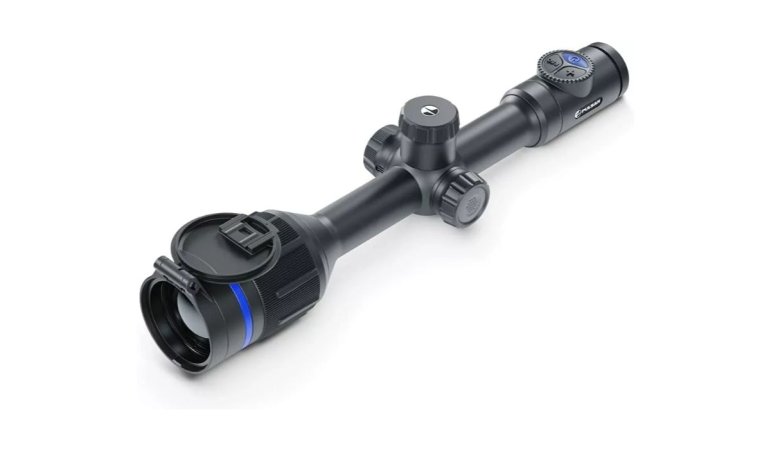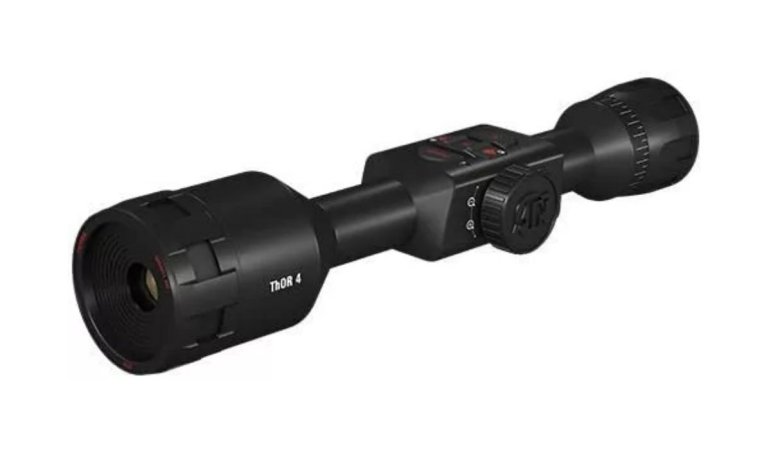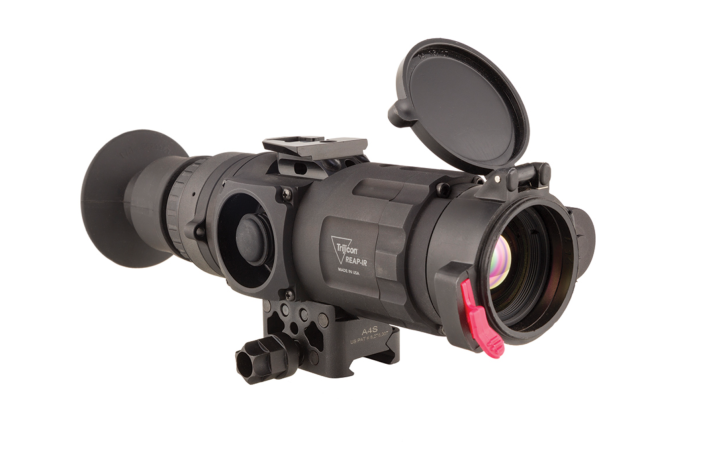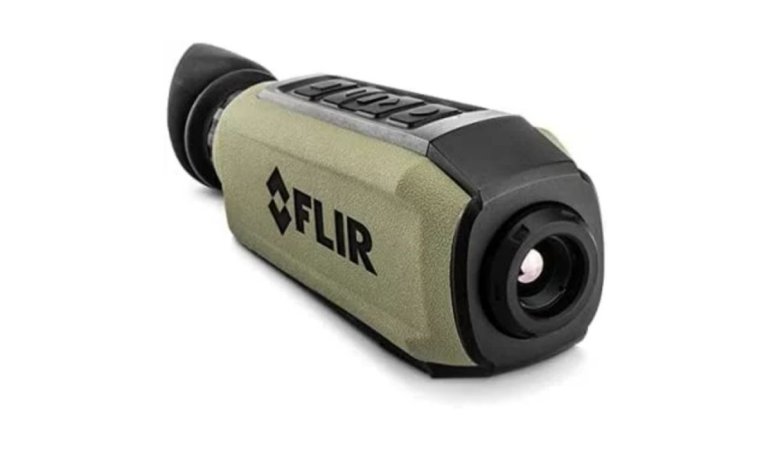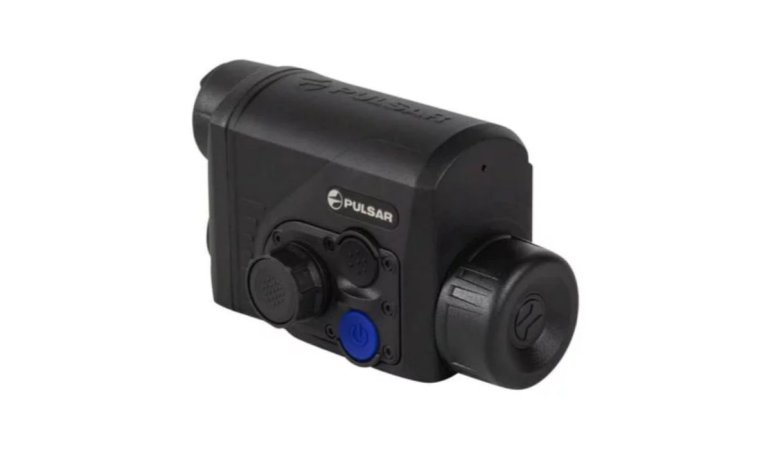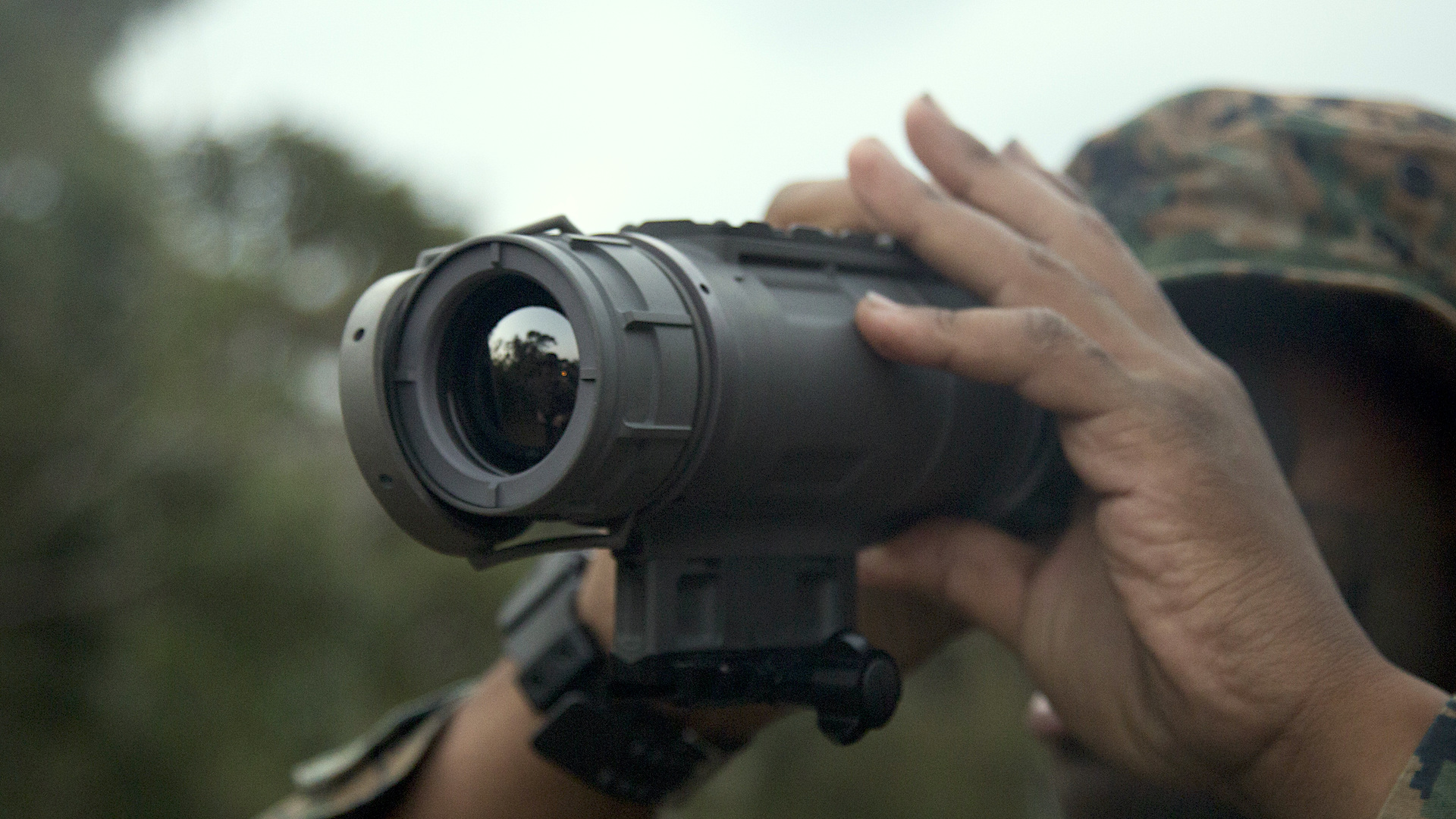

We may earn revenue from the products available on this page and participate in affiliate programs.
Hollywood would have you believe that thermal scopes impart superhuman vision to anyone who possesses one, leaving you vulnerable only to Austrian bodybuilders covered in mud. The crazy thing is that, unlike giant fireballs from grenades or magazines that never run out of ammunition, thermal scopes are actually crazier in real life than they seem in the movies.
Don’t fall into the trap of thinking that thermal optics are the less-useful little cousin to night vision. The two are more different than alike, and thermal technology can offer a tremendous tactical advantage. For starters, they’re just as effective during daylight as they are after dark. Digital internals can allow displays to include compass readings, distance as measured by a laser rangefinder, and heat images custom-tailored to your needs. Some can even tag targets and share them across other devices.
Thermal scopes have proven their worth in the military for decades. Law enforcement officers use them for everything from search and rescue operations to engagements with hostile suspects. Hunters use them to get an edge in pursuit of predator species and invasive hogs. Whatever your purpose is, prepare to have your mind blown by how valuable thermal imaging can be. There’s a lot to learn before you invest in a thermal scope of your own, so allow us to recommend a few of our favorites and provide some background information for context.
- Best Overall: Pulsar Thermion 2 XP50
- Best Value: ATN Thor 4
- Editor’s Choice: Trijicon REAP-IR
- Best Handheld: Teledyne FLIR Scion OTM266
- Best Clip-On: Pulsar Proton FXQ
Best Overall
Pulsar Thermion 2 XP50
Pros
- Recoil-rated for most rifles
- Capable of detecting targets up to 2,000 yards away
- Premium detail and clarity
- Fits standard 30-millimeter scope rings
Cons
- Extra batteries are very expensive
- Mastery will take considerable training time
- Too expensive for recreational shooting
Product Specs
- Configuration: Rifle scope
- Thermal core: 640 x 480
- Display: 1024 x 768 AMOLED
- Pixel pitch: 17 microns
- Refresh rate: 50 hertz
Best Value
ATN Thor 4
Pros
- Reticle automatically adjusts as you zoom
- Option to upgrade the sensor and eyepiece
- Share information with other users
- Three camouflage options available
Cons
- Limited range compared to premium alternatives
- Water-resistant, not waterproof
- Information on display type is not readily available
Product Specs
- Configuration: Rifle scope
- Thermal core: 384 x 288
- Display: 1280 x 720 (type not available)
- Pixel pitch: 17 microns
- Refresh rate: 60 hertz
Editor’s Choice
Trijicon REAP-IR
Pros
- Premium OLED display is very desirable
- Relatively compact and light
- Satisfies the MIL-STD-810G durability standard
- Three objective lens sizes available
Cons
- Only four hours of battery life
- Limited selection of reticles and color schemes
- Menu and controls seem clunky
Product Specs
- Configuration: Rifle scope
- Thermal core: 640 x 480
- Display: (size not available) OLED
- Pixel pitch: 12 microns
- Refresh rate: 60 hertz
Best Handheld Thermal Scope
Teledyne FLIR Scion OTM266
Pros
- Premium display quality in a portable monocular
- Durable and IP67 waterproof-rated
- Stream live video via Wi-Fi
- Comes with six color schemes
Cons
- Very expensive for a monocular thermal device
- Most affordable version uses a very slow refresh rate
- Consumes batteries six at a time
Product Specs
- Configuration: Monocular
- Thermal core: 640 x 480
- Display: 1280 x 960 (type not available)
- Pixel pitch: 12 microns
- Refresh rate: 60 hertz
Best Clip-On Thermal Sight
Pulsar Proton FXQ
Pros
- Add thermal capabilities to your existing setup
- Extremely sensitive thermal core detects tiny variations in temperature
- Satisfies IPX7 waterproof standards
- Magnesium alloy body is light and strong
Cons
- Adds more weight than a dedicated thermal scope
- Relatively bulky when combined with your existing scope
- Adapter must fit your current objective lens
Product Specs
- Configuration: Clip-on sight
- Thermal core: 384 x 288
- Display: 1024 x 768 AMOLED
- Pixel pitch: 17 microns
- Refresh rate: 50 hertz
Why you should trust us
Our quest to bring you the best gear available has resulted in expert gear guides on everything from shooting accessories to the latest fitness equipment. We take extra pride in encouraging responsible firearm ownership, and that includes taking pride in your marksmanship. We’re here to help you achieve accurate shooting with gear guides on the best scopes, red dots, and iron sights. Once you’ve made your choice, we found bore sights to make dialing your system of choice a breeze. A thermal scope is a much bigger investment — probably more than the rifle you’re mounting it to — so we made sure to seek out only the best products worthy of your money.
Types of thermal scopes
On the surface, there are basically thermal optics that are designed for handheld use and thermal scopes that can be mounted to a firearm. Both styles have their place and both include entry-level options all the way up to top-shelf products. Your first step is to determine how you plan to use your fancy new thermal scope. Then, you can get into the technical features.
Handheld thermal scopes
The simplest way to get a thermal view of the world is with a handheld monocular that isn’t designed as a rifle scope. These devices use the same technology to create a heat-based image, but don’t need to incorporate a reticle or mounting system. Optics like the Teledyne FLIR Scion OTM have a proven track record of success in the military, law enforcement, and civilian arenas.
The biggest advantage of owning this kind of thermal optic is the ability to use it without pointing a weapon. That can be key during a search for a missing person, an attempt to identify a subject who has recently fled the scene of a crime, or when you need to track down game animals in the brush. With proper training, it can potentially be used to identify weapons and body armor under clothing. You may be able to determine whether an approaching person is male or female, and even visualize physical exertion in the form of increased body temperature.
Standard thermal scopes
Thermal imaging presents a massive tactical advantage when mounted to a firearm. Scopes like the Pulsar Thermion 2 XP50 and Trijicon REAP-IR offer impressive capabilities in hunting and tactical environments. Because these systems are digital, you can change your reticle and color scheme on the fly. Some even have a one-shot-zero feature and can save profiles for multiple weapons or ammunition. The amount of customization in a quality thermal scope is astounding.
Unlike night vision, thermal imaging requires no light to function, resulting in a distinct advantage in dense vegetation, under cloud cover, and during moonless nights. One important thing to remember is that the real world is not a shooting range — target identification may be the biggest challenge you face. Thermal scopes have three effective ranges: detection, recognition, and identification. While you may be able to see a person or animal nearly 2,000 yards away, being able to tell the difference between a hog and a calf or spot a weapon is another story entirely.
Clip-on thermal sights
If you aren’t ready to dedicate a rifle to thermal use, a clip-on sight can be a great solution. These optics aren’t much cheaper than a thermal scope, but they can be combined with your existing scope when you need thermal capabilities and removed when you don’t. A clip-on thermal sight like the Pulsar Proton FXQ can turn your existing rifle setup into a technological marvel in no time.
The downside of adding a clip-on thermal sight to your rifle is added complexity. You’ll have two optics to control instead of one, and reaching your thermal sight might be a stretch. It will also be heavier than using a dedicated thermal scope. Either approach is viable and both have devoted followers.
Vehicle-mounted
We’ll go out on a limb and guess that you’re not shopping for the kind of thermal optics they mount on attack helicopters or C-130J gunships. Still, they exist and — we imagine — have capabilities far beyond what’s made public.
Key features of thermal scopes
The first time you get your hands on a thermal scope, you’re probably going to feel like you discovered alien technology — and you’ll probably feel a little overwhelmed. Allow us to reduce the initial shock with a walk-through of thermal scope basics, and check out The Late Night Vision Show if you really want to dive into the rabbit hole of thermal optics.
One thing to keep in mind is that, because thermal optics are digital, technology progresses much faster than what you’d see in traditional scopes, red dot or holographic sights, or even analog night vision optics. Unlike the 20-year-old technology in a Gen 3 PVS-14 that’s still relevant today, a thermal optic that’s four to five years old will be showing its age considerably.
Thermal core
Thermal imaging starts with the thermal core. This component is an image sensor like the ones you’d find in digital cameras, except it detects thermal energy rather than visible light. A higher-quality thermal core will produce a higher quality image as long as the rest of the components are able to keep up. The more sensitive a thermal core is, the more detailed information you’ll receive. This is measured in a tiny temperature unit called a millikelvin. Most modern thermal scopes have a thermal sensitivity of 50 millikelvin, with some of the best achieving 35 millikelvin.
Standard thermal cores measure somewhere between 320 and 384 pixels on the horizontal axis. The best thermal cores available right now measure 640 pixels wide and 480 pixels high and create incredibly detailed images. Both are usable, but a premium core can be very nice to have. After thermal information is received, it gets passed on to the device’s processor. The scope’s internal computer converts it into visible light that your eyes can understand.
Display
The visible representation of the thermal information gets delivered via a display inside the optic, and the materials used to build displays can vary. Originally, thermal scopes used light-emitting diode displays. You can still find LED examples today, but they’re considered obsolete and should generally be avoided. Mainstream, competitive thermal optics use liquid crystals on silicon or ferroelectric liquid crystals on silicon. These LCOS and FLCOS displays produce much better images and are considered the current standard. At the top end of thermal devices are organic light-emitting diode and active-matrix organic light-emitting diode displays. These OLED and AMOLED displays offer benefits like richer colors, lower battery consumption, and superior brightness compared to the alternatives.
Display quality is also affected by “pixel pitch,” or the distance between pixels measured in microns from center to center. The lower the number, the better the image quality. Early thermal scope displays had a pixel pitch of 25 microns. Today, 17 microns is considered by many to be the industry standard. The consensus seems to be that 12-micron displays are the current hotness — and about as small as the human eye can detect.
Refresh rate
Because thermal scopes use digital displays, you’re effectively watching a live video feed when you use one. Think of refresh rate as the frames per second used to describe conventional video. Most thermal imaging devices have a refresh rate of 30 hertz, meaning you get a new image 30 times per second. That’s more than adequate for use on foot, but if you use your thermal scope in a moving vehicle, you may notice lag. In that case, an optic with a faster refresh rate might be worth paying more for. Some are rated at 50 hertz and others are rated at 60 hertz, but both rates are faster than the human eye can detect and will produce the same effective results.
In addition to producing a fresh image 30 to 60 times per second, thermal optics must occasionally clear the core to prevent images from being burned in and appearing as a ghost image later. This process is called a non-uniformity correction. When this happens, you may see the display lock up momentarily and there may be an audible click — your scope isn’t broken, that’s normal and necessary. Your thermal scope will likely perform a NUC automatically at predetermined intervals. Manual control may also be available, allowing you to avoid being interrupted at the wrong moment. Some optics require a manual NUC with the lens cap in place. Your user manual will outline the process for whichever thermal scope you choose.
Objective lens
Whether you shoot a rifle or a camera, you’ve probably been conditioned to associate objective lens size with quality. When dealing with visible light, that’s often true, but it doesn’t necessarily work that way with thermal imaging.
For starters, the amount of magnification a scope provides will have an effect. To create two scopes with an identical field of view at different magnification levels, the scope with greater magnification will require a larger objective lens. You may also be surprised to know that thermal optics don’t use glass objective lenses. Glass does a poor job of transferring heat, so thermal devices use lenses made from germanium instead. Grades of germanium can vary, so getting quality lenses is important. Remember to consider the bigger picture before comparing optics based on their objective lenses.
Eyepiece
One component that commonly gets overlooked is the eyepiece. It’s an important piece, no doubt, but perhaps not as critical as the thermal core, digital display, and objective lens. As a result, it’s often the first component on the chopping block when a manufacturer needs to cut costs. If you see two thermal scopes that seem similar on the spec sheet but have a significant price difference, one probably has a more expensive eyepiece.
Benefits of thermal scopes
Being able to see heat is a pretty awesome tactical advantage. Because thermal scopes are digital, you’ll also get some pretty wild perks that you may not have anticipated. Once you get the hang of it, you’ll be able to customize everything from your zero to your display’s appearance. You can also record the action and review it for training purposes or share an epic hog hunting trip with your friends.
Smart integration with your weapon
As with any scope, you’ll have to sight in your thermal scope and establish a zero before you can use it effectively. This is much easier than sighting in a traditional optic, and there’s no need to fire a series of groups and walk them onto the target with incremental adjustments. You’ll probably be able to set an accurate zero with a single shot with a thermal scope. Many of our picks even allow you to save multiple presets, so you can have precise zeroes for different loads of ammunition at your fingertips.
Digital displays also allow you to change reticles on the fly. Want to switch from mil-dot to a bullet-drop compensator or change the color of your reticle? Go right ahead. You’ll be free to combine the reticle style and color with the image you see to get the best results possible.
Multiple color schemes
Depending on your environment, the typical white-hot or black-hot thermal display might not be ideal. A good thermal scope will allow you to switch between the two and adjust the contrast. That’s one of the reasons older LED displays aren’t desirable; diodes are never completely off, so the display can’t create true black and the result is a grayed image.
Furthermore, modern thermal scopes offer a selection of color palettes to choose from. The Pulsar Thermion 2 XP50 includes eight color schemes that excel in different situations, allowing you to prioritize detection, accuracy, or reduced eye fatigue. Part of getting to know your thermal scope is familiarizing yourself with these options and learning to recognize when to use each one.
Record what you see
Thermal scopes use digital sensors and computer processors, so adding the ability to record photos and videos is low-hanging fruit for manufacturers. In most cases, it’s as simple as pressing a button to take a photo and holding it to record video.
Hunters use this feature to share their experiences. Guides find it especially useful for showing prospective clients what they can expect and getting them up to speed on thermal scopes if they don’t have one of their own. In a tactical setting, this can be an invaluable training tool. You can revisit your shooting during a hot wash or use a handheld thermal optic to record your team’s movements for them to review later.
Thermal scope pricing
Budget
Thermal optics rely on seriously advanced technology, which unfortunately means that products we recommend start around $2,000. You can get thermal imaging for less, and it might be fine for casual use. If you want to keep tabs on your dogs when they’re off-leash or just learn a new skill, something more basic might be just what you need.
The ATN OTS LT, for example, keeps costs down with basic color schemes and inexpensive internals. The 1280-by-960 display is appealing, but note that it’s being fed by a very small 160-by-120 thermal core and image quality is nowhere near what our picks for this list offer. If that doesn’t bother you, save a bundle and pick this up for $899 (at press time). Otherwise, keep looking.
Mid-range
You probably noticed that our value pick checks in at just shy of $2,000. That’s a significant chunk of change, but the benefits compared to a budget thermal scope make upgrading a no-brainer for anyone who plans on shooting with their thermal scope.
Between there and the $5,000 Pulsar Thermion XP50, you’ll be able to safely browse products with thermal imaging sensors at least 300 pixels wide, quality displays, fast refresh rates, and crystal clear germanium objective lenses. Reticles and color schemes will be changeable on the fly and you can expect a healthy range of user-friendly features like video recording and one-shot zero capabilities.
Premium
Once you spend more than $5,000, you’re likely entering the world of advanced professional equipment. These thermal scopes offer far beyond what most users will ever need. They’re intended for hunting guides, law enforcement agencies, and military units.
The Trijicon REAP-IR is one example. Every single component is top-shelf, and the compounding effects result in an extremely capable thermal scope that we’d trust to have our back anywhere. Prices start at $7,000 and go up to $9,500 depending on which options you choose, but we can’t argue with the performance. Sometimes you get what you pay for.
How we chose our top picks
Buying a thermal scope should be about adding capability to your arsenal, not checking a box with a receipt. That’s why we immediately ruled out anything that uses inferior or outdated technology. To be considered, all devices had to pass our minimum requirements of a thermal core measuring at least 300 pixels on the horizontal axis, an LCOS display or better, and 17-micron pixel pitch. That left us with only quality products, and we were free to narrow down the selection based on user-friendliness and unique characteristics.
FAQs on thermal scopes
You’ve got questions, Task & Purpose has answers.
Q: What thermal scope does the U.S. military use?
A: We’re sure there are other optics in use around the world, but the PAS-13 is what most service members are likely to encounter. This thermal scope was developed by Raytheon and the U.S. Army.
Q: How long does a thermal scope last?
A: Thermal scopes do not suffer from the same kind of degradation experienced by analog night vision devices. You’re much more likely to trade up for a newer model than you are to experience a system failure.
Q: How far can you shoot with a thermal scope?
A: In this case, range has far more to do with target identification than controlling your point of impact. Can you land rounds several hundred yards out? Sure. Can you tell what you’re destroying? Probably not. Our resident machine-gunner, Travis Pike, remembers a time when he couldn’t identify whether an approaching person was armed until they came within 100 yards.
Q: Can thermal rifle scopes be used in daylight?
A: Absolutely. Thermal imaging devices have been used by the military, law enforcement, and hunters for all kinds of daytime applications.
